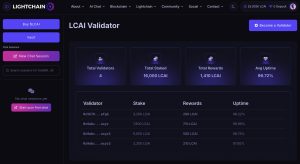In the fast-moving intersection of blockchain and AI, Lightchain AI is shaping an ecosystem built on transparency, scalability, and community participation. The protocol’s latest updates highlight a push toward practical decentralization—giving users, validators, and developers more direct influence over how the network evolves.

Whether you’re staking a little or a lot, you’ll have the tools to track performance and grow your rewards.
The centerpiece of this vision is LCAI Governance, launched just over a week ago. Unlike top-down models, Lightchain AI’s framework hands decision-making power to the community. Members can propose and vote on adjustments ranging from validator rewards to staking rules. This structure turns governance into a living mechanism—ensuring the protocol grows through collective input rather than centralized mandates.
Beyond governance, Lightchain AI is focusing on usability. Upcoming features for its LCAI assistant include chat history, integrated web search, and seamless session switching—tools designed to make interacting with blockchain-based AI feel natural and intuitive. The goal is clear: make decentralized AI as user-friendly as a familiar chat app, while opening the door to more advanced real-time applications.
For validators, the network is preparing to launch a dedicated dashboard that puts transparency front and center. Users will be able to track validator performance, staking volumes, uptime, and rewards from a single interface. By lowering barriers to entry, Lightchain AI is encouraging broader participation in securing the network while offering clear incentives for contributors.
Taken together, these developments illustrate Lightchain AI’s approach: build practical tools, hand control to the community, and strengthen network reliability through inclusivity. As blockchain and AI increasingly converge, the project is positioning itself as more than a protocol—it’s aiming to be an ecosystem where decentralization meets usability.




